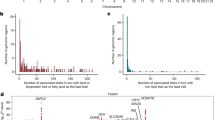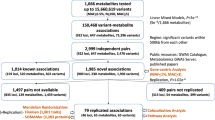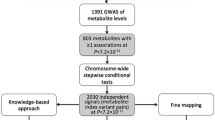Abstract
Nuclear magnetic resonance assays allow for measurement of a wide range of metabolic phenotypes. We report here the results of a GWAS on 8,330 Finnish individuals genotyped and imputed at 7.7 million SNPs for a range of 216 serum metabolic phenotypes assessed by NMR of serum samples. We identified significant associations (P < 2.31 × 10−10) at 31 loci, including 11 for which there have not been previous reports of associations to a metabolic trait or disorder. Analyses of Finnish twin pairs suggested that the metabolic measures reported here show higher heritability than comparable conventional metabolic phenotypes. In accordance with our expectations, SNPs at the 31 loci associated with individual metabolites account for a greater proportion of the genetic component of trait variance (up to 40%) than is typically observed for conventional serum metabolic phenotypes. The identification of such associations may provide substantial insight into cardiometabolic disorders.
This is a preview of subscription content, access via your institution
Access options
Subscribe to this journal
Receive 12 print issues and online access
$209.00 per year
only $17.42 per issue
Buy this article
- Purchase on SpringerLink
- Instant access to full article PDF
Prices may be subject to local taxes which are calculated during checkout


Similar content being viewed by others
References
Schlessinger, B.S., Wilson, F.H. Jr. & Milch, L.J. Serum parameters as discriminators between normal and coronary groups. Circulation 19, 265–268 (1959).
Stumvoll, M., Goldstein, B.J. & van Haeften, T.W. Type 2 diabetes: principles of pathogenesis and therapy. Lancet 365, 1333–1346 (2005).
Dupuis, J. et al. New genetic loci implicated in fasting glucose homeostasis and their impact on type 2 diabetes risk. Nat. Genet. 42, 105–116 (2010).
Kolz, M. et al. Meta-analysis of 28,141 individuals identifies common variants within five new loci that influence uric acid concentrations. PLoS Genet. 5, e1000504 (2009).
Teslovich, T.M. et al. Biological, clinical and population relevance of 95 loci for blood lipids. Nature 466, 707–713 (2010).
Wang, T.J. et al. Metabolite profiles and the risk of developing diabetes. Nat. Med. 17, 448–453 (2011).
Dunn, W.B., Broadhurst, D.I., Atherton, H.J., Goodacre, R. & Griffin, J.L. Systems level studies of mammalian metabolomes: the roles of mass spectrometry and nuclear magnetic resonance spectroscopy. Chem. Soc. Rev. 40, 387–426 (2011).
Suhre, K. et al. Human metabolic individuality in biomedical and pharmaceutical research. Nature 477, 54–60 (2011).
Illig, T. et al. A genome-wide perspective of genetic variation in human metabolism. Nat. Genet. 42, 137–141 (2010).
Gieger, C. et al. Genetics meets metabolomics: a genome-wide association study of metabolite profiles in human serum. PLoS Genet. 4, e1000282 (2008).
Soeters, P.B. & Fischer, J.E. Insulin, glucagon, aminoacid imbalance, and hepatic encephalopathy. Lancet 2, 880–882 (1976).
1000 Genomes Project Consortium. A map of human genome variation from population-scale sequencing. Nature 467, 1061–1073 (2010).
International HapMap 3 Consortium. Integrating common and rare genetic variation in diverse human populations. Nature 467, 52–58 (2010).
Surakka, I. et al. Founder population–specific HapMap panel increases power in GWA studies through improved imputation accuracy and CNV tagging. Genome Res. 20, 1344–1351 (2010).
Hindorff, L.A. et al. Potential etiologic and functional implications of genome-wide association loci for human diseases and traits. Proc. Natl. Acad. Sci. USA 106, 9362–9367 (2009).
Natt, E., Kida, K., Odievre, M., Di Rocco, M. & Scherer, G. Point mutations in the tyrosine aminotransferase gene in tyrosinemia type II. Proc. Natl. Acad. Sci. USA 89, 9297–9301 (1992).
Orinska, Z. et al. TLR3-induced activation of mast cells modulates CD8+ T-cell recruitment. Blood 106, 978–987 (2005).
Marone, G., Galli, S.J. & Kitamura, Y. Probing the roles of mast cells and basophils in natural and acquired immunity, physiology and disease. Trends Immunol. 23, 425–427 (2002).
Cross, L.J., Heaney, L.G. & Ennis, M. Histamine release from human bronchoalveolar lavage mast cells by neurokinin A and bradykinin. Inflamm. Res. 46, 306–309 (1997).
Bouatia-Naji, N. et al. A polymorphism within the G6PC2 gene is associated with fasting plasma glucose levels. Science 320, 1085–1088 (2008).
Prokopenko, I. et al. Variants in MTNR1B influence fasting glucose levels. Nat. Genet. 41, 77–81 (2009).
Shin, Y., Vaziri, N.D., Willekes, N., Kim, C.H. & Joles, J.A. Effects of gender on hepatic HMG-CoA reductase, cholesterol 7α-hydroxylase, and LDL receptor in hereditary analbuminemia. Am. J. Physiol. Endocrinol. Metab. 289, E993–E998 (2005).
Rosipal, S., Debreova, M. & Rosipal, R. A speculation about hypercholesterolemia in congenital analbuminemia. Am. J. Med. 119, 181–182 (2006).
Koot, B.G., Houwen, R., Pot, D.J. & Nauta, J. Congenital analbuminaemia: biochemical and clinical implications. A case report and literature review. Eur. J. Pediatr. 163, 664–670 (2004).
Zhao, M. et al. FcγRIIB inhibits the development of atherosclerosis in low-density lipoprotein receptor–deficient mice. J. Immunol. 184, 2253–2260 (2010).
Hernández-Vargas, P. et al. Fcγ receptor deficiency confers protection against atherosclerosis in apolipoprotein E knockout mice. Circ. Res. 99, 1188–1196 (2006).
Cohen, P.T. Protein phosphatase 1—targeted in many directions. J. Cell Sci. 115, 241–256 (2002).
Chasman, D.I. et al. Forty-three loci associated with plasma lipoprotein size, concentration, and cholesterol content in genome-wide analysis. PLoS Genet. 5, e1000730 (2009).
Aulchenko, Y.S. et al. Loci influencing lipid levels and coronary heart disease risk in 16 European population cohorts. Nat. Genet. 41, 47–55 (2009).
Bergstrom, J.D. & Reitz, R.C. Studies on carnitine palmitoyl transferase: the similar nature of CPTi (inner form) and CPTo (outer form). Arch. Biochem. Biophys. 204, 71–79 (1980).
Willer, C.J. et al. Newly identified loci that influence lipid concentrations and risk of coronary artery disease. Nat. Genet. 40, 161–169 (2008).
Kathiresan, S. et al. Six new loci associated with blood low-density lipoprotein cholesterol, high-density lipoprotein cholesterol or triglycerides in humans. Nat. Genet. 40, 189–197 (2008).
Wallace, C. et al. Genome-wide association study identifies genes for biomarkers of cardiovascular disease: serum urate and dyslipidemia. Am. J. Hum. Genet. 82, 139–149 (2008).
Zhang, S. et al. Genetic and environmental contributions to phenotypic components of metabolic syndrome: a population-based twin study. Obesity (Silver Spring) 17, 1581–1587 (2009).
Isaacs, A. et al. Heritabilities, apolipoprotein E, and effects of inbreeding on plasma lipids in a genetically isolated population: the Erasmus Rucphen Family Study. Eur. J. Epidemiol. 22, 99–105 (2007).
Marchini, J., Howie, B., Myers, S., McVean, G. & Donnelly, P. A new multipoint method for genome-wide association studies by imputation of genotypes. Nat. Genet. 39, 906–913 (2007).
Li, Y., Willer, C.J., Ding, J., Scheet, P. & Abecasis, G.R. MaCH: using sequence and genotype data to estimate haplotypes and unobserved genotypes. Genet. Epidemiol. 34, 816–834 (2010).
Aulchenko, Y.S., Ripke, S., Isaacs, A. & van Duijn, C.M. GenABEL: an R library for genome-wide association analysis. Bioinformatics 23, 1294–1296 (2007).
Mägi, R. & Morris, A.P. GWAMA: software for genome-wide association meta-analysis. BMC Bioinformatics 11, 288 (2010).
Soininen, P. et al. High-throughput serum NMR metabonomics for cost-effective holistic studies on systemic metabolism. Analyst 134, 1781–1785 (2009).
R Development Core Team. R: A Language and Environment for Statistical Computing (R Foundation for Statistical Computing, Vienna, Austria, 2007).
Inouye, M. et al. An immune response network associated with blood lipid levels. PLoS Genet. 6, e1001113 (2010).
Ding, J. et al. Gene expression in skin and lymphoblastoid cells: refined statistical method reveals extensive overlap in cis-eQTL signals. Am. J. Hum. Genet. 87, 779–789 (2010).
Teo, Y.Y. et al. A genotype calling algorithm for the Illumina BeadArray platform. Bioinformatics 23, 2741–2746 (2007).
Acknowledgements
We thank all the Finnish volunteers who participated in the studies. We thank the IT Center for Science and the technology center of the Institute for Molecular Medicine Finland for providing the computational facilities required in this study. The expert technical assistance for statistical analyses provided by A. Vikman, I. Lisinen, V. Aalto and the Genotyping Facilities at the Wellcome Trust Sanger Institute are gratefully acknowledged. The study was supported through funds from The European Community's Seventh Framework Programme (FP7/2007-2013), the BioSHaRE Consortium (261433), the Sigrid Juselius Foundation (251217 to S.R.), the Academy of Finland (137870 to P.S. and 135973 to P.W.), the Responding to Public Health Challenges Research Programme of the Academy of Finland (129269 to M.J.S., 129429 to M.A.-K., 129322 to M.P. and 139635 to V.S.), the Academy of Finland Center of Excellence in Complex Disease Genetics (213506 and 129680 to A.P., J. Kaprio, L.P., K.S. and S.R.), the Finnish Foundation for Cardiovascular Research (to M.J.S., M.A.-K., M.P., S.R. and K.H.P), the Jenny and Antti Wihuri Foundation (to A.J.K.), the Instrumentarium Science Foundation (to T.T. and P.W.), the Finnish Cultural Foundation (to T.T. and T.L.), an Aalto University School of Science and Technology researcher training scholarship (to T.T.) and the Wellcome Trust (098051 to A.P.). The Young Finns Study has been financially supported by the Academy of Finland (126925, 121584, 124282, 129378 (Salve), 117787 (Gendi) and 41071 (Skidi)), the Social Insurance Institution of Finland, the Turku University Foundation, the Yrjö Jahnsson Foundation, the Emil Aaltonen Foundation (to T.L.), the Medical Research Fund of Tampere University Hospital, the Turku University Hospital Medical Fund, the Juho Vainio Foundation, the Finnish Foundation for Cardiovascular Research (to T.L.) and the Tampere Tuberculosis Foundation (to T.L. and M.K.). The Helsinki Birth Cohort Study has been supported by grants from the Academy of Finland (120386, 125876 and 126775 to J.E.), the Finnish Diabetes Research Society, the Novo Nordisk Foundation, the European Science Foundation (EuroSTRESS), the Wellcome Trust (89061/Z/09/Z and 089062/Z/09/Z), the Samfundet Folkhälsan and the Finska Läkaresällskapet. The FINRISK/DILGOM study was supported by the Academy of Finland (118081). Data collection for FinnTwin12 and FinnTwin16 were supported by the National Institute on Alcohol Abuse and Alcoholism (NIAAA) (AA-12502, AA-09203 and AA-08315 to R.J.R. and AA-15416 to D.M.D.) and the Academy of Finland (100499, 205585, 118555 and 141054 (Skidi-Kids) to J. Kaprio). The Finnish Twin cohorts are also supported by the Novo Nordisk Foundation, the Diabetes Research Foundation, Biomedicum Helsinki and Helsinki University Central Hospital grants (all to K.H.P.). NFBC1966 received financial support from the Academy of Finland (104781, 120315, 129269, 1114194, 139900 and SALVE to M.-R.J. and Center of Excellence in Complex Disease Genetics to L.P.), University Hospital Oulu, Biocenter, University of Oulu (75617 to M.-R.J. and M.J.S.), the European Commission EURO-BLCS Framework 5 award (QLG1-CT-2000-01643 to M.-R.J.), the US National Heart, Lung, and Blood Institute (NHLBI) (5R01HL087679), the US National Institute of Mental Health (NIMH) (1RL1MH083268), European Network for Genetic and Genomic Epidemiology (ENGAGE) (HEALTH-F4-2007-201413 to L.P. and M.-R.J.), the MRC UK (G0500539, G0600705 and PrevMetSyn/Salve to M.-R.J.) and the Wellcome Trust (GR069224).
Author information
Authors and Affiliations
Contributions
Experiments were designed by L.P., M.P., M.A.-K., A.P. and S.R. Statistical analyses were performed by J. Kettunen, T.T., A.O.-A., E.T. and L.-P.L. Materials and/or analysis tools were contributed by J. Kettunen, T.T., A.-P.S., P.S., A.J.K., P.W., K.S., D.M.D., R.J.R., M.J.S., J.V., M.K., T.L., K.H.P., M.I.M., A.J., J.E., O.T.R., V.S., J. Kaprio, M.-R.J., N.B.F., M.A.-K., A.P. and S.R. The manuscript was written by J. Kettunen, T.T., A.J.K., M.I., N.B.F., M.A.-K., A.P. and S.R. All authors reviewed the manuscript.
Corresponding author
Ethics declarations
Competing interests
The authors declare no competing financial interests.
Supplementary information
Supplementary Text and Figures
Supplementary Table 1–6 and 8, Supplementary Figures 1–4 and Supplementary Note (PDF 3440 kb)
Supplementary Table 7
All metabolite associations P < 2.31×10−10 (XLSX 2480 kb)
Rights and permissions
About this article
Cite this article
Kettunen, J., Tukiainen, T., Sarin, AP. et al. Genome-wide association study identifies multiple loci influencing human serum metabolite levels. Nat Genet 44, 269–276 (2012). https://doi.org/10.1038/ng.1073
Received:
Accepted:
Published:
Issue Date:
DOI: https://doi.org/10.1038/ng.1073



